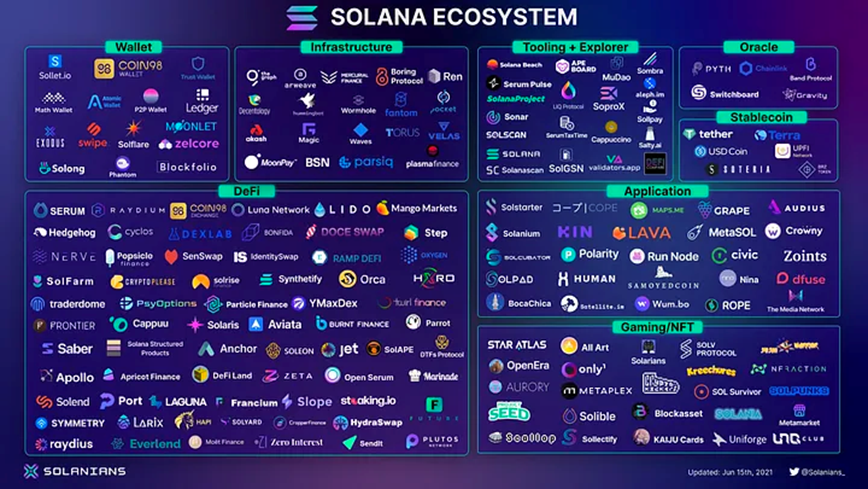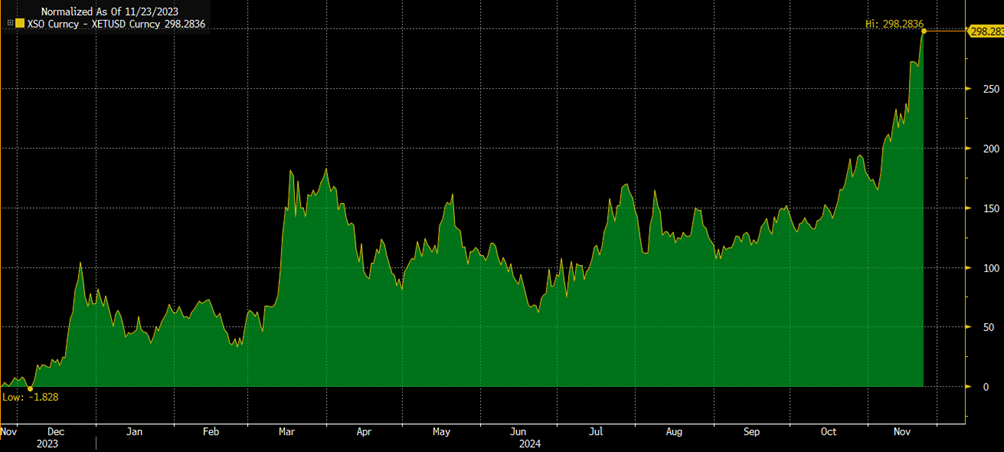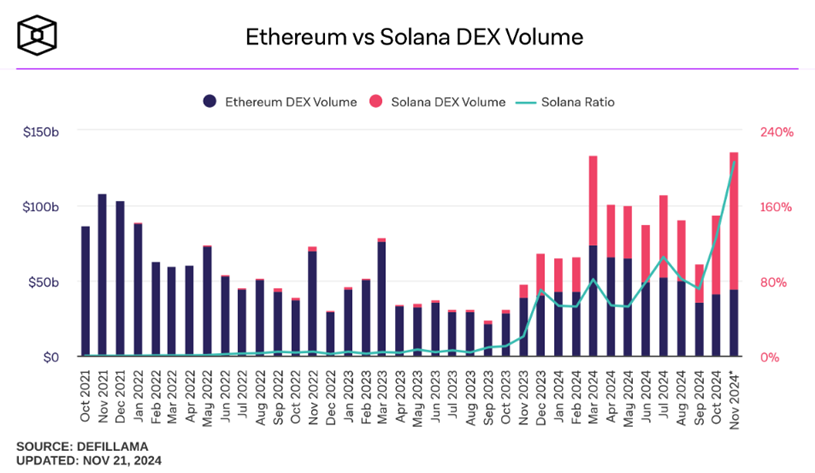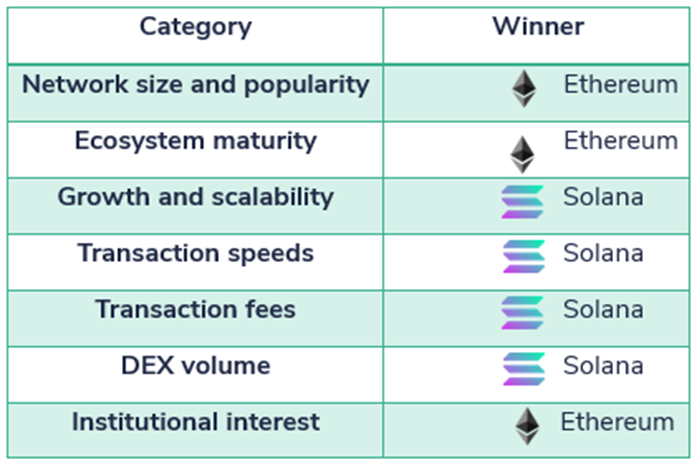Solana and Ethereum are two dominant blockchains in the crypto sector, each boasting robust DeFi ecosystems and a plethora of diverse applications. The two blockchains are often seen as competitors. How do they compare?
Introduction
The re-election of former President Donald Trump, the first crypto-friendly President of the United States, sparked renewed interest in blockchain technology, drawing attention not only to Bitcoin, the largest cryptocurrency, but also to the broader crypto ecosystem. This article examines two other heavyweight contenders dominating the crypto space: Ethereum, recognized for introducing smart contracts and decentralized applications (dApps), and Solana, a fast-growing competitor famous for its high transaction speed and low fees. A case is to be made on both sides.
The Origins
To truly compare Ethereum and Solana, one must begin with their origins. Ethereum, the second largest cryptocurrency, was proposed in 2013 and launched in July 2015 by Vitalik Buterin and several co-founders, including Gavin Wood, Anthony Di Iorio, and Charles Hoskinson. It was born out of the limitations they observed in Bitcoin’s scripting capabilities. Buterin envisioned a blockchain platform capable of supporting more complex applications beyond the simple transfer of value like peer-to-peer contracts and decentralized applications. Ethereum introduced the concept of "smart contracts," allowing developers to create decentralized applications and manage assets via its native cryptocurrency, Ether (ETH). Ethereum's ability to enable decentralized finance (DeFi) and non-fungible tokens (NFTs) helped it become the go-to blockchain platform for developers.
Meanwhile, Solana was launched in March 2020 by Anatoly Yakovenko and Raj Gokal. Yakovenko, a former engineer at Qualcomm (NASDAQ:QCOM), sought to solve Ethereum's scalability issues. Solana’s primary goal was to create a high-performance blockchain capable of processing thousands of transactions per second with low fees. It quickly gained traction in decentralized applications and attracted a growing developer community, positioning Solana as the fourth-largest cryptocurrency by market capitalization.
Unlike Bitcoin, which was created as an alternative to traditional fiat currency, Ethereum and Solana serve additional goals. Users pay a fee in Ether or Solana to perform actions on their respective networks. In other words, both Ethereum and Solana are programmable blockchains that provide developers with the ability to use their decentralized infrastructure to create projects, a feature that Bitcoin does not offer.
Consensus Mechanisms
Ethereum transitioned from a Proof of Work (PoW) consensus mechanism to Proof of Stake (PoS) in 2022 with the "Merge" upgrade. PoW, used originally by Bitcoin and Ethereum, involves miners solving complex mathematical puzzles using computational power to validate transactions and add new blocks to the blockchain. This process is energy-intensive, it requires substantial hardware and electricity. In contrast, PoS replaces miners with validators who lock up a certain amount of cryptocurrency as collateral. Validators are selected to propose new blocks based on the amount of cryptocurrency they have staked, rather than their computational power. Users must stake a minimum of 32 ETH to become a validator in Ethereum's PoS system. PoS offers several benefits, including greater energy efficiency, lower hardware demands, reduced centralization risks, and enhanced security through validator incentives.
Solana goes one step further with a hybrid consensus mechanism that combines PoS with Proof of History (PoH). PoH introduces the concept of timestamping, through a Verifiable Delay Function (VDF) that generates timestamps for each transaction. This allows the network to verify the time elapsed between events without extensive communication between nodes. Additionally, PoH uses a sequential preimage-resistant hash function to link hashes together, each hash depending on the previous one. This process creates a chain where altering any hash would require recalculating all subsequent hashes, thus strengthening security and integrity. The combination of PoS and PoH enables Solana to achieve high throughput, processing thousands of transactions per second with low fees.
Tokenomics
Both Ethereum and Solana share a similar fee structure, consisting of a base fee and a priority fee, but the way these fees play out is quite different. On Ethereum, the base fee is burned, creating a deflationary effect on the supply of ETH as more transactions occur, which could potentially drive up the price over time. However, the gas fees on Ethereum can be unpredictable, often fluctuating based on network congestion. Ethereum’s average transaction fee typically ranges between $3 and $10, though during times of high demand, fees can spike, complaints about gas fees reaching $50 or $100, even for minor transactions, are commonly seen on social media. This can be especially frustrating for smaller transactions, where the fee might end up outweighing the transaction itself.
On Solana, 50% of all fees, whether base fees or priority fees, are burned and fees are consistently low, usually just a fraction of a cent, thanks to the high transaction throughput enabled by its PoS-PoH consensus mechanisms. A typical Solana transaction costs around 0.0001 SOL, equivalent to approximately $0.00025. This makes Solana ideal for microtransactions and frequent interactions.
Scalability, a crucial aspect of decentralized networks like blockchains, refers to the ability of a blockchain to handle a growing number of transactions without compromising performance. Both Ethereum and Solana are working on scalability, in different ways. Ethereum’s infrastructure supports approximately 15 transactions per second, often leading to network congestion. To address this, Ethereum, with its larger ecosystem, is leaning on Layer-2 solutions and sharding to improve performance and reduce congestion. Ethereum’s Dencun upgrade incorporates danksharding, a technique that divides the blockchain into smaller segments. This approach is expected to reduce gas fees and improve the overall efficiency of the network. In contrast, Solana’s architecture is designed for high scalability from the start, PoH enables Solana to process transactions much more efficiently than traditional consensus mechanisms by eliminating the need for every node to validate the order of transactions, leading to significantly faster processing times. The network is theoretically capable of processing up to 65,000 transactions per second, today one of the fastest blockchain available. Expected to launch in 2025, the upcoming Firedancer validator client aims to further boost this capacity, potentially processing up to 1 million transactions per second.
Ecosystem Maturity
Ethereum remains the dominant platform for executing complex smart contracts, with a well-established development environment and broad adoption. Since its launch in 2015, Ethereum introduced smart contracts, laying the foundation for decentralized applications. Its first-mover advantage contributed to a larger developer community and widespread adoption. At the time of writing, its total value locked (TVL) stands at an impressive $60.7 billion. With over 4,700 dApps and more than 584,000 unique active wallets (UAWs), Ethereum controls over 50% of the total value locked (TVL) in decentralized finance, making it the largest and most diverse platform in the space. Key DeFi protocols operating on Ethereum such as Uniswap, MakerDAO, and Compound revolutionized the borrowing, lending, and trading landscape in the crypto world.
The platform's dominance extends to the NFT space, with high-value collections like CryptoPunks, Bored Ape Yacht Club, and Pudgy Penguins.
Source: Ethereum ecosystem, Infinito Wallet
Solana, while newer to the scene, has rapidly built a growing DeFi ecosystem. Its TVL of $8.3 billion places it as the third largest DeFi ecosystem, following Ethereum and Tron. With over 350 dApps and 1.3 million UAWs, Solana’s focus on high throughput and low transaction costs has made it an appealing option for DeFi projects.
Solana’s unique consensus mechanism enables faster transaction speeds, attracting DeFi projects like Jupiter, Raydium, and Orca, which leverage Solana’s speed for a more seamless user experience.
Source: Solana ecosystem, Solanians
Ethereum’s large network of over 1 million validators outpaces Solana’s smaller but growing base of approximately 2,000 validators. Market capitalization serves also as a key indicator of the relative scale of these platforms. Ethereum currently holds a market cap of over $397 billion, while Solana's market cap is approximately $116 billion. Despite this gap, Solana's rapidly expanding ecosystem and lower transaction costs have consistently attracted new users and developers. Solana has experienced a 122% increase in market value in 2024, compared to Ethereum's more modest 39% growth during the same period. As of November 2024, Solana's protocol fees, an indicator for revenues, are nearly double those of Ethereum. Data also reveals that Solana generates 24% more income for validators compared to Ethereum.
Relative Performance of Solana (SOL) Versus Ether (ETH) Over 1 Year
Source: Bloomberg
Another important metric is the transaction volume on decentralized exchange platforms (DEXes). In November 2024, Solana’s DEX volume nearly doubled that of Ethereum, with Solana reaching $77.51 billion compared to Ethereum’s $38.81 billion. Solana's daily trading volumes reached a high of $6.88 billion on November 12 and have consistently remained above $6 billion since then. Higher DEX volume is a sign of greater utility and adoption of one blockchain over the other. In this case, it highlights Solana as the preferred choice for traders on decentralized exchanges. Raydium, a leading Solana-based DEX, is a major driver of this growth, accounting for 66% of Solana’s DEX activity. Much of this increase can be attributed to Solana's memecoin boom, which has sparked a trading frenzy. Memecoins are cryptocurrencies inspired by internet jokes or memes, often experiencing rapid popularity due to social media trends and celebrity endorsements.
Source: The Block
Regarding institutional interest, the launch of Ethereum spot exchange-traded funds in the US in July 2024 made the asset more accessible to investors, boosting institutional adoption and increasing funds inflow from traditional finance. Prominent institutions, including BlackRock (NYSE:BLK), are also leveraging Ethereum for real-world asset tokenisation projects. On the other hand, while Solana ETFs have yet to gain approval in the US, Brazil approved two Solana-based exchange-traded funds in 2024. Additionally, Solana attracted attention from financial giants like Visa (NYSE:V), which is enabling cardholders to settle transactions using Solana-based stablecoins.
Source: Syz Bank
Conclusion
The comparison between Ethereum and Solana reveals two leading blockchains, each with distinct strengths and weaknesses. Ethereum’s well-established ecosystem, supported by ongoing upgrades, continues to dominate the DeFi and NFT sectors, while Solana’s focus on high-speed, low-cost transactions is redefining blockchain scalability. Both platforms are actively evolving, working to overcome their respective challenges to better meet the needs of users and developers. From an investment point of view, both cryptocurrencies can be interesting and benefit from the era of deregulation with the arrival of Donald Trump back in office.
